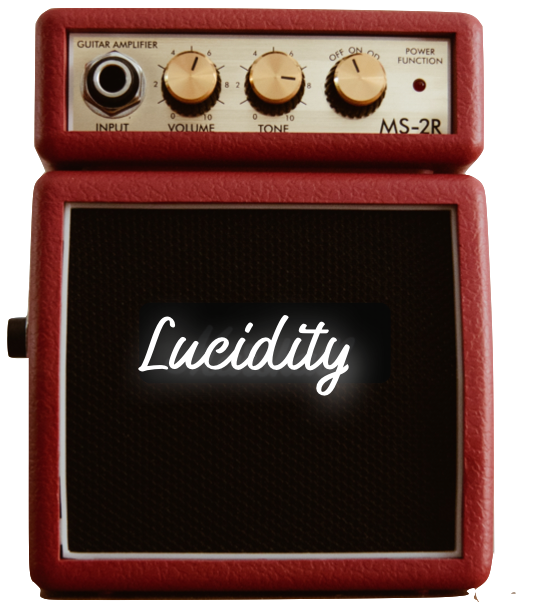The definition of lucid dreaming is fairly straight-forward: Awareness of the fact that one is dreaming during a dream. But once you start practicing lucid dreaming, you’ll start to see how profoundly complex the dreaming state can be.
No two lucid dreams are alike and I’ve found that people tend to grapple with describing their level of lucidity, or how lucid they were during the dream. And understandably so — without any scale or frame of reference, how would anyone know?
So, this article should help clarify the levels of lucidity as I understand them and have experienced them.
Lucidity has amplitude

First, lucidity is awareness or clarity – mental clarity of the fact that you’re dreaming during a dream.
Think of your level of lucidity or awareness as a volume dial you can turn up or down while dreaming. So the higher the dial of awareness is turned, the higher your level of lucidity during your lucid dreams. It’s like tuning into a radio station so the signal is clear and then turning up the volume.
It can be quite helpful to also consider WHAT you are aware of. It’s one thing to realize you’re dreaming and become lucid. It’s another thing when you also realize what you can do while lucid.
Example: “Wow, I am dreaming right now.” But the dream just plays out on its own while you sort of sit back and watch… Compared to, “Wow I am dreaming right now, and that means I don’t have to be afraid!” and you actually change the course of the dream while lucid.
Thinking of lucid dreaming this way should help you benchmark your skill level throughout your practice. So here is a clear scale for the levels of lucidity as I understand it:
1. Non-lucid dreams
 These are just your standard REM sleep dreams.
These are just your standard REM sleep dreams.
The content of the dream can range from pleasant, insightful, prolific, euphoric, to nonsensical, boring, frightening, or just plain weird. The memory of the dream when you wake up could be quite clear; maybe you remembered all the details of the dream very clearly.
But lucidity is about awareness in the present moment; during the dream, not immediately after you awaken. So regardless of the content, or how vivid the dream seemed, or how much you remember upon awakening, if you didn’t know you were dreaming during the dream, it doesn’t count – it’s a non-lucid dream.
2. Sub-lucid dreams
 Sub-lucid implies you were close but no cigar, just below threshold levels. These dreams are very common amongst beginner lucid dreamers.
Sub-lucid implies you were close but no cigar, just below threshold levels. These dreams are very common amongst beginner lucid dreamers.
These dreams are often characterized by searching for lucidity or talking to a dream-character about becoming lucid. The subject of lucidity comes up and you might be skeptical about whether you’re dreaming or not, but you don’t explicitly realize it’s a dream at the time.
At this point, you’re interested, curious, and taking the right steps… but you’re just knocking at the door; it hasn’t opened yet – the dial of awareness has been turned up, but not high enough.
If you don’t have that subjective sense of “Oh wow, I am dreaming right now” during the dream, it still doesn’t count as lucid.
3. Mildly-lucid dreams
 Mild lucidity is when you’re aware you’re dreaming, but it’s a faint awareness and you can’t really change what’s happening. That “Ah-ha” moment … that moment of clarity (lucidity) has been achieved and you know it’s a dream, but it’s fleeting – the dream is hazy, shaky, or short-lived. Mildly lucid dreams often include brief flashes of lucidity that quickly fade.
Mild lucidity is when you’re aware you’re dreaming, but it’s a faint awareness and you can’t really change what’s happening. That “Ah-ha” moment … that moment of clarity (lucidity) has been achieved and you know it’s a dream, but it’s fleeting – the dream is hazy, shaky, or short-lived. Mildly lucid dreams often include brief flashes of lucidity that quickly fade.
Again, the keyword is awareness… You turned the dial of awareness up and you’ve entered into the conscious threshold. Conscious awareness has been activated during a dream, and you either say to yourself “I am dreaming!” or you just know it.
Definitely lucid, yes, but barely. While you are aware you’re dreaming, you may not be aware of the options you now have while lucid. You may not realize the implications or the possibilities that are now open to you since you’ve attained lucidity.
4. Moderately-lucid dreams
 Now we’re talking. The dial of awareness has turned up past the threshold and now you know you’re dreaming. You feel as if you are awake inside your own subconscious mind and you have new freedoms available to you. This can be quite exhilarating.
Now we’re talking. The dial of awareness has turned up past the threshold and now you know you’re dreaming. You feel as if you are awake inside your own subconscious mind and you have new freedoms available to you. This can be quite exhilarating.
And at this level, not only are you aware you’re dreaming, but you also know that now, you have the ability to experiment! Now that you’re in a lucid dream, you can work on ‘controlling’ the dream, maintaining lucid awareness, and influencing what happens in the dream before you lose lucidity, or before you wake up.
What do you want to do? Maybe you want to fly through buildings or plunge deep into the ocean and explore the depths… but how skilled are you?
At this moderate level, you have opened the door and you’ll see there is an entire universe to explore. You’ll experience first hand, that there is much learning to be done, and skills to develop.
How long can you maintain lucidity without getting distracted or too excited and waking up?
5. Fully-lucid dreams
 At the highest levels of lucidity, not only are you 100% lucid in the dream state, but you’re also more comfortable. The dial of awareness is turned up as high as it goes. However, your abilities to influence events may still vary. Your ability to fly, teleport, time-travel, engage with people, etc. will still depend on how calm and focused you are within your lucid dream.
At the highest levels of lucidity, not only are you 100% lucid in the dream state, but you’re also more comfortable. The dial of awareness is turned up as high as it goes. However, your abilities to influence events may still vary. Your ability to fly, teleport, time-travel, engage with people, etc. will still depend on how calm and focused you are within your lucid dream.
It takes practice to get to this point, much of which will likely be spent in the lower levels of lucidity. So, once you’ve attained this level, it’ll be to your advantage to focus less on self-entertainment and exploration and bring a more sincere, respectful attitude to the dream. You’ll get more value out of fully lucid dreams if you use that time wisely.
Learn to improve lucidity
Along your journey into your mind, it’s useful to have these benchmarks so you establish goals, identify your skill level, and develop your practice. If you want to learn more, check out the app. You’ll learn how to turn the dial of awareness and navigate your levels of lucidity.
What level have you been able to reach? Feel free to share your experiences in the comments or reach out with questions by subscribing below!

10 thoughts on “Levels of Lucidity”
I appeared in my dream asking someone if this is a dream then I appeared again and was very happy. Looked around at my home and asked what color I would prefer the walls to be. What decorations would be the best? I know now that yellow painted walls with half red and blue stripes on white letters would look great. Then other things happened
See, this is your subconscious mind working on creative problem-solving! This is what the mind does in dreams all the time, it provides all sorts of interesting ideas. Even though this is just about home decor, the really fascinating thing is that it shows you a detailed image or a preview of what you could create in real life. Keep it up, and thanks for sharing!
I once realized I was in a dream and decided to fly in between nyc skyscrapers and over the ocean. Then, I lost control and ended dropping in and out of the ocean as i was flying just above the water. Very cool experience when you can control your dreams or know that you are dreaming.
Hey sorry for the late reply, but this is awesome! So you got lucid, decided to take action… realized it wasn’t as easy as you thought it would be, but it was possible. This is something you can practice and improve upon over time! I’m a clumsy flyer myself, but it’s still so fun when I do it!
So I know that I’m dreaming I can remember a lot of them but I can’t control them. Even if it’s a nightmare I never am able to control them. I have a lot of zombie like post apocalyptic dreams. Or there super random things happening. How can I get more in control.
Hey Cherish! This is exactly what the course in the app teaches. You should download it today, email me at jason@mindawakeapp.com, and I’ll help you learn dream control.
I don’t fly over cities or dive through oceans or change time, but I am able to control the dream I am inside, like moving around, talking, jumping and all. I once became a friendly werewolf on an alien planet (very weird), I couldn’t change it, but I could move around, know it was a dream, and interact with others in the dream. Is this a mild-lucid dream or a moderate one?
I lucid dream several times a year… never know when they’re coming and I don’t try. Once I realize I’m in the dream I start “exploring”, realizing I can do whatever I please. Sometimes it’s just exploring new places…being in Europe, though I’ve never been. Once, I was in 1972 and just walked around experiencing that time period as an adult instead of as a 3 year old (my age in 1972). Lucid dreaming has also been a place where I can do things knowing there are no consequences for my actions. Unfortunately I have had no control over when the dream ends. It’s always been like a fragile reality that I treasure as long as it lasts… but that I can’t figure out how to hold on to. Also, I’ve never figured out what makes me have a lucid dream. During my most recent lucid dream I was falling asleep reflecting on my life in the early 1990s as a 20-something, dreaming of simpler times. I reflected for so long I suddenly found myself back in time, but in a lucid dream, in my own past world. The strange thing was that as I was “exploring” (walking around akin to like in a video game) scenes would begin to reconstruct but imperfectly. For example, I remember a cafeteria with most details but with large areas of tables missing. Hard to explain…but that is my experience of lucid dreaming.
Some years ago, I started practicing to have lucid dreams. After three months, I had a mildly lucid dream but woke up immediately because I got too excited. I stopped pursuing it a few months later when my baby was born, as getting a good night’s sleep became impossible, and because I had only experienced that one lucid dream. I tried to restart the training several times, but finally, a month ago, I remembered to keep a dream journal one morning. Now, it’s been five weeks, and I’ve been reading a lot about lucid dreaming and have had 11 lucid dreams: 2 mildly lucid, 4 moderately lucid, and 5 fully lucid.
In my first fully lucid dream, I was in a lucid dreams class where the teacher taught me that it’s easier to interact with the dream to make changes, at least for now. For example, if I want to be made of water, instead of just trying to transform myself, it’s better to focus on absorbing all the water in my surroundings and transform that way. This really helped me. I’ve had long lucid dreams where I don’t lose control or wake up, and I even managed to make a person disappear just by trying. In my last lucid dream, I flew—though it was difficult because I was very slow at first. But after focusing, within a second, I was flying all over China at great speed, trying to take down a spaceship that was destroying the Great Wall of China.
And now I found your website so I’ll fully immerse in that. I’m impressed in how different the results have been this time.
PS. Last time I didn’t know about the hand reality check and it has been super useful in several dreams.
Hey Jonathan! It’s great to read your experiences with lucid dreaming and I’m happy to see you’re getting better with practice. Have you checked out the app? Are you interested in personal coaching?